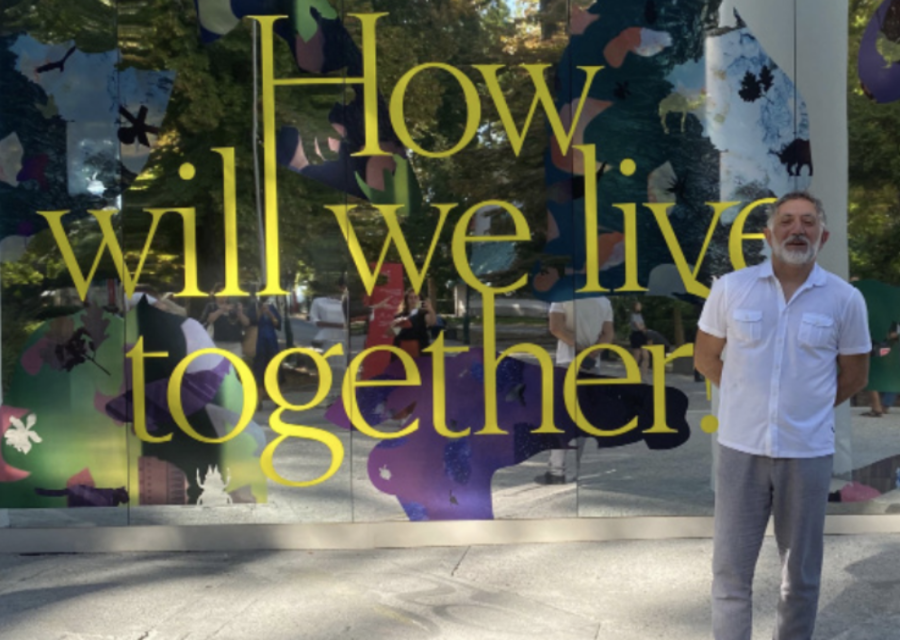‘How will we live together?’
P’22 helps global architects discover ‘what the future of architecture needs’
September 9, 2021
Every other year, Venice, Italy, hosts the Biennale Architettura, a six-month global showcase of the world’s most innovative architects’ work. Each Biennale has an overarching theme and several smaller exhibits, or scales, within the theme. This year’s theme, “How will we live together?” has five scales as continuations of that question: “among diverse beings”; “as new households”; “as emerging communities”; “across borders”; and “as one planet.” The Biennale’s curator is responsible for creating the theme and scales and working with the director and a few others to invite the architects and oversee the entire Biennale. Massachusetts Institute of Technology (MIT) School of Architecture Dean Hashim Sarkis P’22 took on the role of curator in October of 2018 for the 2020 Biennale, which was postponed to the spring and summer of 2021. Dr. Sarkis hasn’t gone a day since receiving the role without inviting guests and architects, discovering architectural innovation, creating themes, and planning for the Biennale Architettura, he told The Vanguard when we spoke with him in August.
What did it mean to you and your career to receive the role of curator?
After being asked, I had to first ask if I was able to do it, practically. I had to make sure that MIT and my family were okay with it. After they all said yes, it came down to the intellectual question of whether I’d be able to formulate the theme and invite the people. It meant that I had to take all the knowledge of my life, all of the architecture I’ve seen and known, and extract from it certain ideas and values that I think are important for the future. [Getting this role] meant that I needed to stop thinking about what I would like to do and think more importantly about what I need to do, meaning what architecture needs today—what the future of architecture needs. That required that I look to architects of the next generation, instead of past architects of my generation, to see what they’re thinking about, what they’re doing.
How did you choose the Biennale’s theme?
“How will we live together” is a very old question. It’s a question that has been with us since the beginning of humankind when people decided to come together. Since then, every time we come together, we write a contract—the social contract—to define the practices and spaces in which [we] live. Architects usually follow the norms that politicians, sociologists, and society itself and its cultures impose on life. We try to represent the best of society in our spaces and improve on those social practices by giving them the spaces that accommodate them. But sometimes those social norms become tired and out of sync. And it’s important for us to ask the question: “How will we live together?” every now and then from different perspectives.
I asked the question from the point of view of architecture because the politics of 2018 and 2019, when I began planning for the Biennale, [were] not giving us the right answers. We’re facing major crises, climate change, political polarization between right and left, extremes in income levels in equities, and massive migration and inequities among ethnic groups, all which we continue to face. And since we humans always imagined ways of how we live together, I thought, “why not ask the architects; maybe they can come up with answers.” There is no one answer to this question, but we can learn there are alternative models to living together than the ones that we are confined to.
How can architects address larger world issues?
Architects bring the ability to imagine spaces into existence. It’s very difficult for us to imagine the impact that climate change will have on our lives. We somehow feel the temperature is higher, but the fact that this is going to transform the planet altogether requires a way of representing it visually to explain it to us. This cannot stop at words. It has to have pictures, it has to have representations of the real effects, and architects have the best tools for that task. We draw new perspectives, and we are able to produce different scenarios graphically and visually, but we also imagine alternatives. We can ask: “What if we apply engineering solutions of dissipating the ocean current before it reaches buildings using huge dams or reflecting the sunlight towards a centralized solar field? What would that produce as a planet?”
The use of imagination in architecture is very important. However, architecture—meaning the man-made environment— currently produces about half of the carbon emissions in the world. So surely if we architects apply better solutions to carbon emissions in our buildings, then we will contribute to the reduction of carbon emissions. It’s a very direct question of how we can improve on the concrete parts of solar energy, choice of materials, net emissions, etc. And then there’s the architecture imagination: being better connected with our context, being more attentive to the environment around us. This is why so much of the Biennale addresses many of those climate questions with creative approaches that will hopefully inspire even more creative solutions.
What have you learned throughout the festival?
Many, many things, and they’re still coming. I learned that it is important to present architecture to the general public in ways that are not so professional to try to make architecture speak to the world at large. That was a very big challenge both for me and for the hundreds of architects who participated, but it’s a very rewarding challenge because more than 50% of the visitors of the Biennale are not architects, so you have to show them the value of architecture and to speak to them about architecture without the jargon of the profession.
I think the other dimension that I learned in the Biennale has to do a lot with collaboration. For the longest time, we’ve always thought of art and architecture as being too much about the single author, but I realized that the collaborative dimension of architecture is very important. We worked very hard to make that possible through the way that the projects are not just produced by one team in one country but by many teams at once. We try to involve non-architects like artists, engineers, politicians, and others in the shaping of architecture.
How has the public’s view of architecture shifted during the pandemic?
Where can I start? The pandemic has made us aware of architecture, much more than ever before. We now can measure six feet with our eyes. We know the dimensions of every room. We know what is inside and what is outside, what is safe and what is not, what is hygienic and what is not. And we know the dangers that architecture can bring and the level of safety it can bring to our lives. We also use architecture in defining our Zoom spaces: we always choose the space we want to convey. We’ve invited people into our houses in a way that we’ve never done before. So architecture has become very present despite the fact that we say we’re living in isolation and away from each other.
After seeing architecture from all over the world in the Biennale, do you view the architecture of Cambridge differently?
We are privileged to have created, within the spaces of Cambridge, possibilities of living together in ways that maybe the rest of the world doesn’t have. I also feel that this privilege has not played out well in terms of experimentation, meaning that there are many possibilities for playgrounds, but we only have one type. There are many possibilities of public spaces, but they tend to not encourage public interaction. There are experiments from around the world that I’ve seen from Armenia to Nairobi in Kenya to the favelas of Venezuela—the squatter settlements, which create amazing public spaces for people to have even the tiniest moments and possibilities [to connect]. In Armenia, there is a way in which educational institutions can provide the public spaces for people to come together that we can also add to our lives in Cambridge. I think Cambridge can benefit from [looking] across the world for other examples of innovation in architecture.


